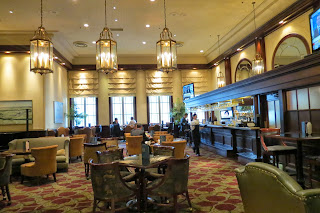You knew it was
coming. And now, having been here almost 24 hours, I stand ready to deliver. Why do I hate Vancouver? The first reason is the Seawall
that encircles Stanley Park. Today is nothing but sunshine here and of course
we went walking along that wall. Yes, in T.O. we have the boardwalk in the Beach,
and you can spot me there on any given day, either walking or cycling. But here
we have greater potential distance, and you can see freighters
standing out to sea, and beyond the horizon, well, to me that looks like the magic of
the Orient. Doesn't everybody who lives in not-Vancouver hate the Seawall?
Reason two is the
SkyTrain. We saw it whizzing joyously past as we rolled into Van on VIA-Rail’s
Canadian, and immediately I felt my gorge rise. The SkyTrain is a light rapid
transit system featuring 70 km of track, spectacular views of the city, and 95%
on-time reliability. It is precisely what we need in Toronto, but cannot have
because of what we did to ourselves at the last municipal election. You know
it, I know it, the whole world knows it.
The third reason I
hate Van, where once UBC granted me an MFA, is that it marks the end of the
line for The VIA-Rail, 50 Canadians, Ocean-to-Ocean, Book-Tour Extravaganza.
We’ve spent the past couple of weeks crossing the country on Train # 1, getting
on and off to promote 50 Canadians Who
Changed the World, staying at historic railway hotels (at present the
magnificent the Hotel Vancouver), beating the drum for a contest that could win you a $5,000 travel voucher, and generally enjoying the trip of a lifetime . .
. and arriving in Van marks the beginning of the end? Of course that makes me bilious.
But wait: we’re here
for a few days more. That photo above? Our Hero ankle deep in the Pacific?
That’s just one ocean. We're talking ocean-to-ocean, remember? The Atlantic is yet to come. Vancouver-lovers, as you were.































